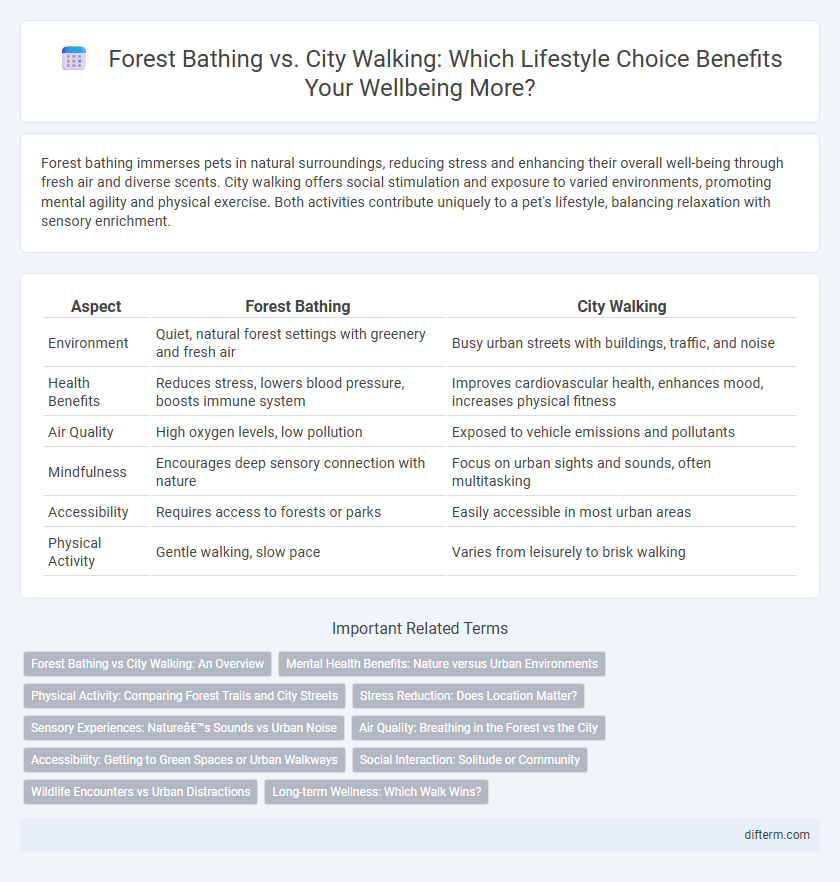Forest bathing immerses pets in natural surroundings, reducing stress and enhancing their overall well-being through fresh air and diverse scents. City walking offers social stimulation and exposure to varied environments, promoting mental agility and physical exercise. Both activities contribute uniquely to a pet's lifestyle, balancing relaxation with sensory enrichment.
Table of Comparison
| Aspect | Forest Bathing | City Walking |
|---|---|---|
| Environment | Quiet, natural forest settings with greenery and fresh air | Busy urban streets with buildings, traffic, and noise |
| Health Benefits | Reduces stress, lowers blood pressure, boosts immune system | Improves cardiovascular health, enhances mood, increases physical fitness |
| Air Quality | High oxygen levels, low pollution | Exposed to vehicle emissions and pollutants |
| Mindfulness | Encourages deep sensory connection with nature | Focus on urban sights and sounds, often multitasking |
| Accessibility | Requires access to forests or parks | Easily accessible in most urban areas |
| Physical Activity | Gentle walking, slow pace | Varies from leisurely to brisk walking |
Forest Bathing vs City Walking: An Overview
Forest bathing, known as Shinrin-yoku, immerses individuals in natural woodland environments to reduce stress and enhance mental clarity by engaging all senses. In contrast, city walking offers urban stimulation with its diverse architecture and social interactions but often exposes walkers to pollution and noise, limiting relaxation benefits. Studies reveal forest bathing significantly lowers cortisol levels and blood pressure compared to city walking, emphasizing the restorative effects of nature immersion.
Mental Health Benefits: Nature versus Urban Environments
Forest bathing immerses individuals in natural environments rich in phytoncides, which reduce cortisol levels and enhance mood regulation, leading to decreased stress and anxiety. City walking offers mental stimulation through diverse stimuli and social interactions but often fails to provide the restorative benefits associated with green spaces. Studies consistently show that exposure to forests improves cognitive function and emotional well-being more effectively than urban settings.
Physical Activity: Comparing Forest Trails and City Streets
Forest bathing on natural trails enhances cardiovascular health through uneven terrain and fresh air, promoting improved lung function and reduced stress hormone levels. City walking often involves flat, paved surfaces that support consistent aerobic exercise but expose pedestrians to higher pollution and noise levels. Studies indicate that forest environments boost overall well-being more effectively, combining physical activity with mental restoration.
Stress Reduction: Does Location Matter?
Forest bathing significantly reduces cortisol levels and heart rate, promoting a deeper state of relaxation through exposure to natural phytoncides and green spaces. City walking, while accessible, often includes stressors such as noise pollution and crowds that can limit its calming effects despite physical activity benefits. Scientific studies highlight that immersive nature experiences yield greater stress reduction compared to urban environments, emphasizing the importance of location in achieving mental well-being.
Sensory Experiences: Nature’s Sounds vs Urban Noise
Forest bathing immerses individuals in natural soundscapes like rustling leaves, bird songs, and flowing water, which promote relaxation and mental clarity. In contrast, city walking exposes people to urban noise pollution such as traffic, sirens, and crowd chatter, often increasing stress levels and sensory overload. Studies show that natural sounds enhance mood and reduce cortisol, while persistent urban noise correlates with higher heart rates and decreased cognitive performance.
Air Quality: Breathing in the Forest vs the City
Forest bathing exposes individuals to cleaner air enriched with phytoncides and higher oxygen levels, which enhance respiratory health and reduce stress hormones. In contrast, city walking often involves inhaling pollutants like nitrogen dioxide, particulate matter, and volatile organic compounds that compromise lung function and increase inflammation. Choosing forest environments for daily walks significantly improves air quality intake, promoting better overall wellness compared to urban settings.
Accessibility: Getting to Green Spaces or Urban Walkways
Forest bathing often requires traveling to natural parks or reserves, which may be less accessible for urban residents without personal transportation. City walking offers immediate access to sidewalks and pedestrian-friendly streets, making it easier for most people to incorporate into daily routines. Proximity to green spaces varies greatly by city, impacting the feasibility and frequency of forest bathing compared to urban strolls.
Social Interaction: Solitude or Community
Forest bathing encourages solitude and mindfulness, fostering deep personal reflection and a calming connection with nature's tranquility. City walking promotes social interaction through spontaneous encounters and communal engagement amid urban vibrancy. Choosing between these activities depends on whether one seeks introspective solitude or dynamic community connection.
Wildlife Encounters vs Urban Distractions
Forest bathing offers immersive wildlife encounters, allowing individuals to connect deeply with birdsong, rustling leaves, and diverse ecosystems often absent in urban settings. City walking exposes people to urban distractions such as traffic noise, digital screens, and crowded sidewalks, which can hinder mindfulness and reduce stress-relief benefits. Engaging with nature during forest bathing enhances mental clarity and emotional well-being by fostering a sensory connection with natural habitats.
Long-term Wellness: Which Walk Wins?
Forest bathing enhances long-term wellness by reducing cortisol levels, improving cardiovascular health, and boosting immune function through exposure to phytoncides emitted by trees. City walking provides cardiovascular benefits and mental stimulation but often exposes individuals to higher pollution and stress levels, potentially diminishing overall health gains. Studies indicate forest bathing offers superior sustained stress reduction and immune support, making it the more effective choice for long-term wellness.
forest bathing vs city walking Infographic

 difterm.com
difterm.com